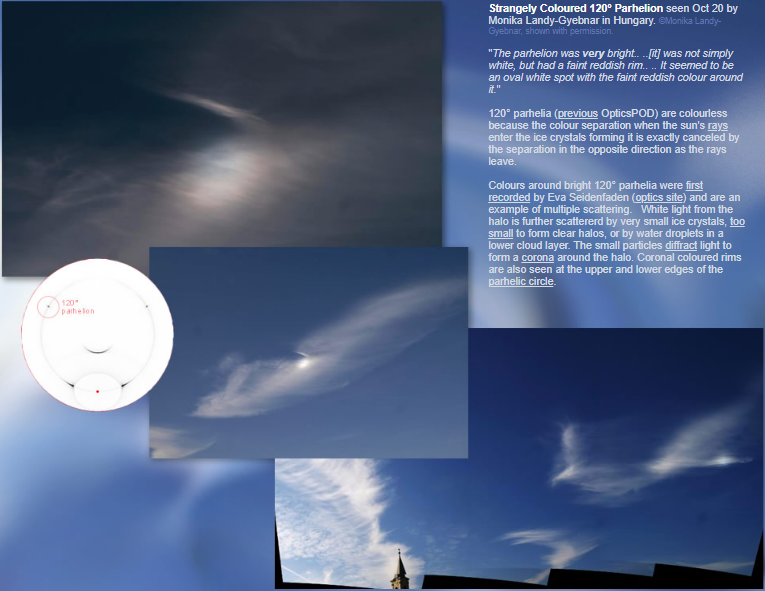Strange Halo Colours
Strange Halo Colors: A Phenomenon of Atmospheric Optics
Have you ever gazed up at the sky and been captivated by the beauty of a halo surrounding the sun? These luminous rings of light are a result of atmospheric optics, and they can display a wide range of colors. While most halos appear colorless, there are instances where strange halo colors, such as reddish rims or vibrant corona, can be observed. In this article, we will explore the fascinating phenomenon of strange halo colors and delve into the scientific explanations behind them.
The Enigma of the 120° Parhelion
One particular instance of strange halo colors is the 120° parhelion. Unlike its colorless counterparts, the 120° parhelion often exhibits a faint reddish rim, adding an intriguing twist to its appearance. Observers have described it as an oval white spot surrounded by a subtle reddish hue. This deviation from the norm has piqued the curiosity of atmospheric optics enthusiasts worldwide.
The Colorless Nature of 120° Parhelia
It is worth noting that 120° parhelia are typically colorless. This is due to a fascinating optical phenomenon that occurs when sunlight passes through ice crystals, which form these halos. As the sun's rays enter and exit the ice crystals, the separation of colors is precisely canceled out, resulting in a colorless display. However, the presence of strange halo colors challenges this notion and calls for further investigation.
Multiple Scattering: Unveiling the Mystery
To unravel the mystery behind strange halo colors, we turn to the concept of multiple scattering. First documented by Eva Seidenfaden, multiple scattering occurs when white light from a halo is scattered by very small ice crystals or water droplets present in a lower cloud layer. These particles, too minuscule to form clear halos themselves, diffract light and create a corona around the halo. It is within this corona that the enigmatic colored rims manifest.
Coronal Colored Rims and the Parhelic Circle
Not only do strange halo colors appear as rims around bright 120° parhelia, but they can also be observed at the upper and lower edges of the parhelic circle. The parhelic circle is a complete circle of light that intersects the horizon at a 120° angle from the sun. The presence of colorful rims in these areas further emphasizes the captivating nature of strange halo colors.
A Glimpse into the Past
As we delve into the world of strange halo colors, it is important to acknowledge the rich history associated with their observation. The recorded sightings of colored rims around bright 120° parhelia date back to Eva Seidenfaden's documentation. These historical accounts provide valuable insights into the occurrence and characteristics of strange halo colors, laying the foundation for further exploration and research.
Unveiling Nature's Palette
The study of atmospheric optics has allowed us to appreciate the intricate beauty and complexity of natural phenomena. Strange halo colors serve as a testament to the awe-inspiring diversity found in our atmosphere. By unraveling the mechanisms behind these peculiar hues, scientists can gain a deeper understanding of light scattering, diffraction, and the interplay between particles and light in our atmosphere.
Exploring Strange Halo Colors: Further Research
While much has been uncovered about strange halo colors, there is still ample room for further investigation. Scientists continue to study the properties of ice crystals, water droplets, and their interaction with light to gain a more comprehensive understanding of the phenomenon. By conducting experiments, analyzing data, and utilizing advanced imaging techniques, researchers strive to unlock the secrets behind these captivating displays.
A Glimpse into the Future
As technology advances and our understanding of atmospheric optics deepens, we can expect to uncover even more intriguing aspects of strange halo colors. The combination of scientific research, observational data, and computational modeling will undoubtedly contribute to unraveling the complexities of this phenomenon. This ongoing exploration will not only enhance our knowledge of atmospheric optics but also provide us with a profound appreciation for the wonders of nature.
A Final Word
Strange halo colors add an element of mystery and wonder to the already captivating world of atmospheric optics. The presence of vibrant corona, reddish rims, and colorful edges around bright 120° parhelia challenges our understanding of how light interacts with ice crystals and water droplets in the atmosphere. By embracing curiosity, conducting thorough research, and collaborating across scientific disciplines, we can hope to unlock the secrets behind these mesmerizing displays and gain a deeper appreciation for the beauty that surrounds us in the sky above.

Strangely Coloured 120° Parhelion seen Oct 20 by Monika Landy-Gyebnar in Hungary. ©Monika Landy-Gyebnar, shown with permission.
"The parhelion was very bright.. ...it. was not simply white, but had a faint reddish rim.. .. It seemed to be an oval white spot with the faint reddish colour around it."
120° parhelia (previous OpticsPOD) are colourless because the colour separation when the sun's rays enter the ice crystals forming it is exactly canceled by the separation in the opposite direction as the rays leave.
Colours around bright 120° parhelia were first recorded by Eva Seidenfaden (optics site) and are an example of multiple scattering. White light from the halo is further scattererd by very small ice crystals, too small to form clear halos, or by water droplets in a lower cloud layer. The small particles diffract light to form a corona around the halo. Coronal coloured rims are also seen at the upper and lower edges of the parhelic circle.
Note: this article has been automatically converted from the old site and may not appear as intended. You can find the original article here.
Reference Atmospheric Optics
If you use any of the definitions, information, or data presented on Atmospheric Optics, please copy the link or reference below to properly credit us as the reference source. Thank you!
-
<a href="https://atoptics.co.uk/blog/strange-halo-colours/">Strange Halo Colours</a>
-
"Strange Halo Colours". Atmospheric Optics. Accessed on April 19, 2024. https://atoptics.co.uk/blog/strange-halo-colours/.
-
"Strange Halo Colours". Atmospheric Optics, https://atoptics.co.uk/blog/strange-halo-colours/. Accessed 19 April, 2024
-
Strange Halo Colours. Atmospheric Optics. Retrieved from https://atoptics.co.uk/blog/strange-halo-colours/.